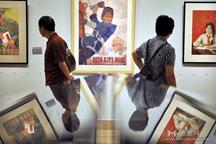60 years of Chinese fine arts
2009-09-28 09:15 BJT
Watch Video

 Play Video
Play Video
From commissioned paintings of political and historical moments to highly individualized executions of different styles and subjects. The development of Chinese art reflects the sweeping changes in Chinese society over the past sixty years. Each turn of event has been recorded on canvas, in detail and with enthusiasm, by generations of Chinese painters. Collectively, they have painted a panorama of a fast-developing society.
A journey back into history invariably leads to this critical moment for the Chinese nation. On October 1st, 1949, Chairman Mao declared the founding of New China. Even from the canvas, the nationwide jubilation is palpable. Experiencing a baptism of war and hardships, many Chinese painters turned to historical subjects in the 1950s.
Their choice of subjects echoed what Chairman Mao proposed. In 1956, during a meeting in Beijing, the late leader said that art should serve the people and socialism. Different views were encouraged under the slogan: "Let a hundred flowers blossom and a hundred schools of thought contend." Mao's speech sent a spasm of change through fine arts.
It all started with an article on the revival of traditional Chinese painting.
Pan Gongkai, president of central academy of fine arts, said, "The reform was to take two forms. One was to adopt western perspectives and techniques to render Chinese subjects. The other was to find a new way in indigenous culture itself. "
The rejuvenation of traditional Chinese painting was championed by artists Li Keran whose landscapes displayed strong vivid colors such as deep reds and turquoise together with western concepts of perspectives and a strong sense of contrast. The new elements are also evident in the paintings of Fu Baoshi, who also celebrated the heroism of the common people or conveyed the majesty of the motherland. New Chinese painting was carried into new heights with the Chang'an School of Painting and its forerunner Shi Lu.
On the other side are the guardians of traditional Chinese painting, Pan Tianshou, Qi Baishi and Huang Binhong, who focused on experimenting with traditional techniques using ink, including shading and layering. They were widely praised for their freshness and spontaneity.
Using a different genre, Chinese oil painters were heading overseas. Renowned painter Jin Shangyi was one of them. Though his early interest focused mainly on revolutionary and historical subjects, Jin is best remembered for his neoclassical style with the portrait "Tajike Bride". A ray of light shines in, leaving half of the bride's facial features in shadow. The elegant tonal quality is what Jin learned in the 50s to 70s from European painters. His colleague Zhan Jianjun is another who benefited from western experiences.

 Mail
Mail Share
Share Print
Print


 Video
Video









 2009 China Central Television. All Rights Reserved
2009 China Central Television. All Rights Reserved